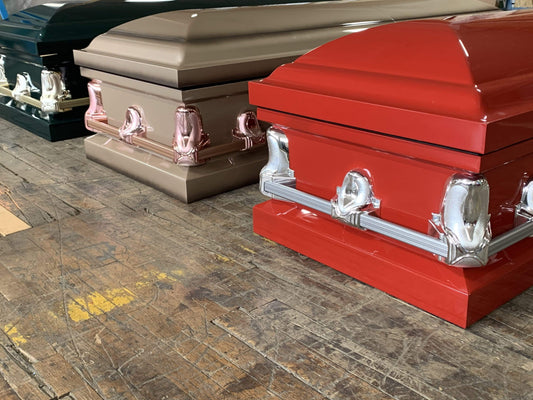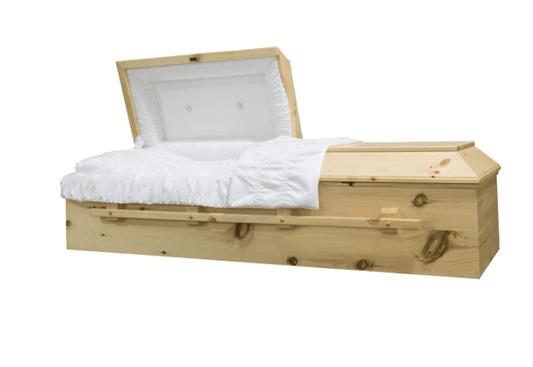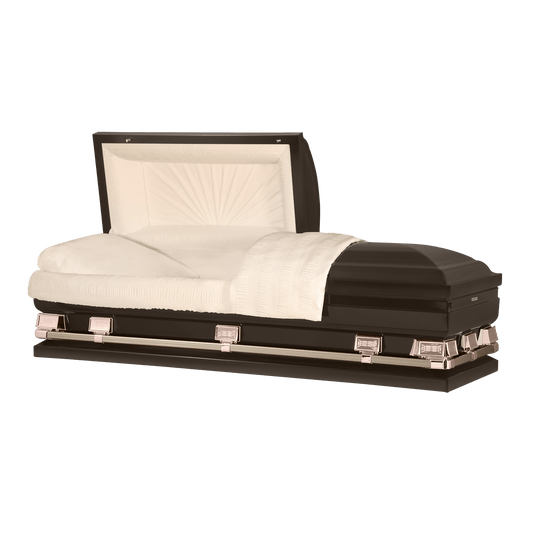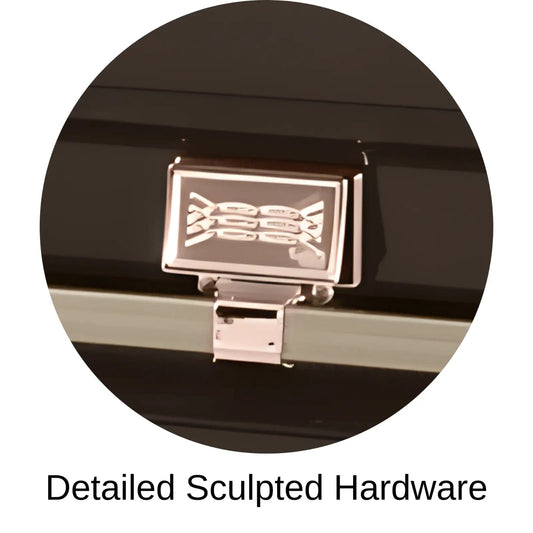Choosing and purchasing a final resting place happens during several different timelines. While cemetery plots are often purchased for immediate use, it is not uncommon for people to purchase a cemetery plot while they are still alive. There are numerous benefits to this pre-need approach: it greatly simplifies the funeral planning process, facilitates coordination between the family, the funeral home and the cemetery, and in many cases, families may choose to buy multiple plots so that eventually loved ones can be buried close together. No matter the timeline, Titan Casket offers a guide on how to choose a cemetery for a final resting place.
Table of Contents
- How Do You Choose A Cemetery?
- How Do You Choose A Cemetery Plot?
- Cemetery Rules And Regulations
- Cemetery And Plot Pricing
- Columbarium, Mausoleum, And Crypt Pricing
- Cemetery Services
How Do You Choose A Cemetery?
Ideally, you will want to choose a tranquil setting in a location with significance to your loved one. Family traditions, military service, religious customs, and a special connection to a given area may all guide you toward choosing a particular cemetery as a final resting place. When the time comes to make these preparations, Titan suggests reviewing some key factors before choosing a final resting place for your loved one.:
Questions to Ask When Choosing a Cemetery for a Final Resting Place
-
Where is the Cemetery Located?
Location is extremely important when choosing a cemetery as a final resting place. Many people choose to purchase a plot in a cemetery within close proximity to their residence. In life, people tend to build communities within a reasonable radius of their home so choosing to buy a plot near, or within, that radius makes grave visitation easier for friends and family. If a plot had not been purchased prior to passing, it is important to consider where a loved one would have wished to be buried. -
What Type of Cemetery is Best for My Loved One?
There are several variations of cemeteries and burial types. The most popular are public cemeteries, national/veterans’ cemeteries, religious cemeteries, and district/municipal cemeteries.
- Public Cemeteries – Public cemeteries are arguably the most popular cemetery type. Public cemeteries are usually owned by an independent individual or corporation and are available to most people as long as they can pay for the burial plot. This type of cemetery can be found easily through an online search, although many people are made aware of public cemeteries through funeral homes or through word of mouth from friends and family.
- National/Veterans’ Cemeteries – National/veterans’ cemeteries are cemeteries run and maintained by the government and allow for the burials of veterans and their families. A veterans’ cemetery provides an honorable military burial (which often includes the folding and presenting of the American flag, the attendance of military personal, playing “Taps,” etc.), along with many aspects of a traditional burial (such as a burial plot, digging and filling of the grave, a gravestone, and gravesite maintenance) at no cost to the veteran's family.
- Religious Cemeteries – Religious cemeteries are cemeteries run by religious institutions such as churches, synagogues, or mosques. Many who have chosen to purchase a burial plot at a religious cemetery are often assisted by religious leaders at their place of worship; going through the burial process with a trusted religious leader often gives people a sense of comfort and relief.
- District/Municipal Cemeteries – District/municipal cemeteries are city/county owned cemeteries that can be found all across America. These types of cemeteries are fairly popular and because of this, many of them are full. It may still be worth it to contact the city, or county, to see if there is any space available in a local district/municipal cemetery.
- Green Cemeteries – Green cemeteries allow for an alternative type of burial that is growing in popularity in modern times. For more on green burials, Titan Casket offers an explanation of green burials vs traditional burials. For more information, click here. – Embalming vs Natural Burial
How Do You Choose A Cemetery Plot?
There are many factors to consider when choosing a plot, including the location of the plot, the type of plot you require (for example, single versus family plots), and the availability of alternative plot options :
-
Where is the Plot Location?
It is important to choose the right plot within a cemetery. Location within a cemetery will influence factors such as gravesite accessibility, proximity to other gravesites, foot traffic, and vegetation. -
What Type of Plots Works Best For Your Needs?
While there are many plot types a cemetery may offer, there are four plot types that tend to be offered the most. These plot types are single plots, plots for cremated remains, family/group plots, and companion plots.
- Single Burial Plots – Single burial plots are by far the most common type of plot offered by cemeteries. These plots are simply dug for a single person, who is usually then buried in a casket or coffin.
- Plots for Cremated Remains – Choosing cremation does not exclude someone from having an accessible, designated place for friends and family to visit. While a cemetery might allow for cremated remains to be buried within a single burial plot besides a casket or coffin, many cemeteries offer a plot for an individual burial of cremated remains. These plots may be smaller in size compared to plots designated for full-body burials, or they may be of similar size and have the ability to fit more than one person’s cremated remains. Some cemeteries may also have a section of land designated for the burial of cremated remains. This section, often referred to as an “urn garden,” is often a less expensive option when compared to purchasing a full-body single plot due to its smaller size (although many cemeteries require the remains to be held in an urn or other appropriate container).
- Family/Group Burial Plots – Some cemeteries offer the ability to purchase a section of land within a cemetery, or several single plots, in order to accommodate multiple burial sites within a close proximity to each other. Most of these spots are purchased for familial use – because of this, people who own these types of plots will often purchase a marker of sorts (such as a plaque, headstone, or monument) to distinguish their specific section of the cemetery.
- Companion Burial Plots – Companion plots are most commonly sold as two single plots adjacent to each other. These types of plots are usually chosen by married couples; however, this plot type is considered to be a reasonable alternative for a family/group plot if one is not available. Although companion plots are often sold as two adjacent single plots, this may not always be the case – sometimes cemeteries (especially those with limited spacing) may sell a companion plot as a plot with similar dimensions as a single plot but dug deeper as to accommodate two caskets or coffins, buried one on top of the other. While each individual having their own designated burial plot may seem more ideal to many, these plots, often referred to as “double depth” plots, are often less expensive than two plots sold together.
- Alternative Plot Options – Cemeteries will often offer plots of land designated for a final resting place option which does not include traditional ground burial. These alternative options are often: columbariums, mausoleums, and crypts.
- Columbariums – A columbarium is a place of storage, usually in the form of a building, for cremated remains. The remains are often held in designated storage cubes, or “niches,” and are given a plaque of sorts (which usually provides the same information as a gravestone) as a means of identification.
- Mausoleums – A mausoleum is a free-standing monument, usually in the form of a building, which acts as a tomb, or burial chamber. There are several types of mausoleums, the most popular being outdoor, indoor, or private (whether the mausoleum is outdoor or indoor is at the discretion of the private owner).
- Crypt –The word “crypt,” comes from the Latin word “crypta,” which translates to “vault.” A crypt is a space (usually made from stone) underneath a building, such as a church, a cathedral, or even a mausoleum. While many crypts still exist underneath religious buildings, in modern times, crypts are also commonly found in cemeteries. It is important to note that while the term “mausoleum,” usually refers to a building, the term “crypt,” refers to the actual designated space for storing remains – which means crypts can be found within a mausoleum. There are several different types of crypts. The four most popular are single crypts, family crypts, companion crypts, and side-by-side crypts.
- Single crypts contain a single person’s remains and are considered to be the most common type of crypt.
- Family crypts (sometimes referred to as “Westminster crypts,”) can contain any number of remains due to the fact that the arrangements are made at the discretion of the family.
- Companion crypts (sometimes referred to as “end-to-end crypts,”) are of similar size to a single crypt however, they contain enough space to hold the remains of two people. Burial containers are often stacked one on top of the other and a single marker is made with information identifying both people inside the crypt.
Side-by-side crypts are similar to companion crypts except that instead of the burial containers being stacked and sharing a marker in a single space, each person has their own individual burial spot (next to each other) and marker.
Cemetery Rules And Regulations
All cemeteries have their own specific rules and regulations, some more strict than others. Such rules and regulations may address anything like monitoring religious customs, the type and size of the gravestone, gravesite visitations, burial site maintenance, and so much more. It is important to understand these rules and regulations before choosing a final resting place and purchasing a plot to make sure the cemetery allows for aspects of a burial that are considered to be important by the departed and his/her friends and family.
Cemetery And Plot Pricing
There are many variables that affect the total price of cemetery burial. For example, for both the plot and the cemetery itself, location and type are extremely important when it comes to pricing. However, when looking at cemeteries, make sure to ask for a price list of all costs, both in the present and in the future. Unfortunately, cemeteries are not legally required to abide by the Funeral Rule, which means they are not legally required to provide consumers with an itemized price list. Although it is not legally required, a quality cemetery should be transparent enough with their pricing that if asked for a price list, they should be able to provide one.
Columbarium And Mausoleum And Crypt Pricing
Like the pricing for a cemetery and ground plot, there are many different factors that can affect the pricing for a columbarium, mausoleum, and crypt. For example, the location of the columbarium, the location of the mausoleum (outdoor, indoor, or private), and the location of the crypt (placement of the storage space, like the distance from the ground) can all change the pricing for these final resting places. Although, in general, all of these burial methods are more expensive options than ground burial.
Plan Your Farewell with Grace – Our Pre-Planned Caskets Offer Peace of Mind
Cemetery Services
Most cemeteries will offer consumers several choices for both full body and cremated remains. For full bodies, cemeteries often offer to perform ground burials and entombments in crypts or mausoleums. For cremated remains, cemeteries often offer to perform ground burials and entombments of remains in a columbarium. Most cemeteries also offer services which include the preparation of the site, site placement, installing a marker (gravestone, plaque, etc.), and gravesite maintenance. Also, a cemetery will often take on the responsibility of obtaining the legally required burial licenses and will maintain records of the burial.

![Upgrade to Premium Weight [18-gauge steel]](http://titancasket.com/cdn/shop/products/casketthicknesswithnumbers.png?v=1680642906&width=533)








